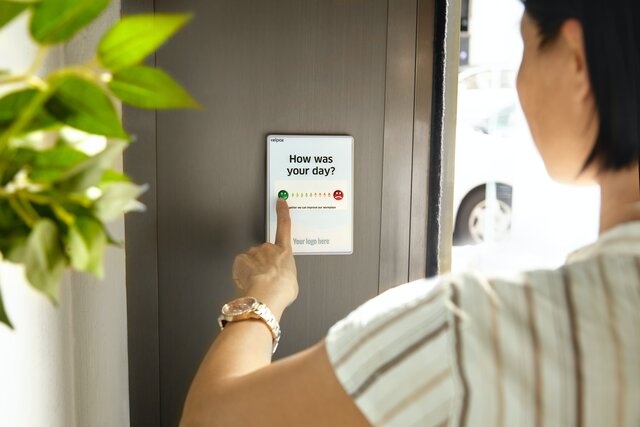Job flexibility has long been seen as the first step to engaging remote employees. As many as 54% of office workers claim they’d leave their current jobs for one that offered more flexible work options.
In fact, this same Gallup study found out that employee engagement rises as people get to work on their own terms. But not on a full-time basis. Top employee engagement rates are noted when 20-40% of work time is spent at the office, together with the rest of the team.
Most reports which correlate schedule flexibility with remote work have noted that face-to-face interaction and meetings are accountable for keeping teams engaged. So here’s where most problems occur: distributed teams rarely get this type of collaboration opportunities.
Employee engagement has long been seen not only in the work process but also with regard to how employees view their employer and how they bond with the rest of the team. Employee loyalty is decreasing each year and keeping your workers engaged and happy at work seems to be the only way of ensuring employee retention.
But the engagement challenges that remote work brings in are entirely different from the ones you’d encounter in a typical office setting.
What makes remote employees less engaged?
Don’t assume this is a recent issue that’s a result of everyone having to work from home. Even before the worldwide “remote work experiment”, two-thirds of remote employees were disengaged.
The number is not shocking once you consider all the issues of day-to-day remote collaboration. You’ve got team members scattered throughout the world, everyone is experiencing their own separate problems with working from home, and your usual communication is now constantly disturbed by external distractions and lagging Internet connections.
The strategies you can use to increase employee engagement are in many ways similar though. They’re just placed in a different environment.
Let’s take a look at some ideas for engaging remote employees you can apply at any time.
Establish clear goals and prioritize tasks

A chaotic workflow or worse, no work methods in place will raise employees’ stress levels and have them looking for the next work opportunity as soon as possible. Aim to offer a clear roadmap of what an employee needs to take care of within a given timeline and keep teams accountable for their work even with minimal supervision.
Then, you’ve got your larger goals. Those steps that every person strives to achieve during their career. Wanting to advance professionally, go into a management position, or just grow their own personal brand are some of the key milestones anyone is looking to get from their future workplace. If you can’t offer these opportunities, your employees will be less motivated to put their best foot forward. Getting the chance to do something for their own development while performing work for their employer can keep them productive and, above all, creative.
Happy employees are the ones who are able to come up with ingenious ideas and help your business in return. All because you care about their own goals, not just your business objectives. If you don’t know where to start, establish SMART goals. In a previous article, we talked about setting SMART goals as a time management hack. Their value though expands beyond this being the perfect way of setting realistic expectations.
This is exactly why you need to communicate with your team as often as possible to find out the best possible ways of achieving their goals and keep your employee engagement efforts running.
Improve your internal communication policies
In particular, make sure to guarantee that face-to-face interactions are a daily occurrence. Yes, daily. As mentioned in the introduction, this is the single most important thing that keeps employees engaged in the long-run.
Simply put, continuous communication keeps every single member of your team aware of what’s going on within the company. Beyond business matters, this has them stay consciously connected with their colleagues.
20% of people who are currently working remotely consider that difficulties with collaboration are their #1 issue. But the reality is that these problems need to be solved by the employer. It’s the company’s responsibility to provide all the tools and policies needed for work within a distributed team to be no different than office work.
Where most companies go wrong here is doing remote communication without a plan. To prevent potentially unproductive situations like employees not bothering to check their messages as often as they should or people losing track of their tasks, cover the next steps:
- Put together a company-wide document to include actionable details that anyone can turn when they can’t find a file, are feeling stuck on an activity, or just don’t know what they’re supposed to be working on.
- Establish clear patterns for meetings, sprint reviews, or any other kind of regular event that will require the participation of more than 2-3 employees.
- Take every team member through a rigorous onboarding process where they’ll get to know all of your policies.
- Make sure everyone has complete access to your communication tools and file storage solutions.
- Prepare an action plan for tackling technical issues.
- Handle background noises that interrupt meetings and recordings using Krisp.
- Provide the right resources to handle both real-time and asynchronous communication.
- Hold regular reviews that won’t add on more stress like the dreaded performance reviews that are much too typical in the office.
[demo]
In all cases, encourage overcommunicating to increase employee engagement. Nobody should fear to reach out to another colleague when they have a problem just because they don’t want to be a nuisance.
One-on-one meetings beyond just work
One method stands out among all techniques that successful distributed teams use to keep employees engaged: regular one-on-one meetings. Commonly, these are held once a week but aim for at least once every other week.
Personal meetings like these ensure no one is feeling isolated or left out. Managers get just enough time to focus on what every single individual has to say. A person-to-person interaction lets you engage with your employees and actively listen and solve every single struggle or wish they have. This shows them you care about them as people, not just workers.
Beyond keeping employees engaged remotely, the real value of a one-on-one meeting lies in the feedback you can get as a company.
On one hand, it’s the single most important thing you can do to show your employees that you’re willing to listen to them and help them achieve their goals. Pair this with actually catering to their individual needs and you’ve got happy employees that are likely to stay with your company for longer. Their own feedback can later be used when hiring new people and crafting a better workplace culture.
On the business side, seeing what’s going well and where work processes are lagging helps you improve your workflows. This, in return, speeds up work while ensuring high-performance standards. That’s especially helpful to have under control when working remotely as everyone could be handling their tasks in different ways or establishing their own schedules that don’t match your company’s project deadlines.
Make it easy for your team members to bond
Closely related to ensuring top communication practices is helping the team bond even when they’re miles away from each other. This is clearly simple in an office environment where you can have weekly events, trips, and even grab lunch together.
All this seems trickier remotely but is just as easy to implement. You just need to turn to video communication and go out of your way to fit in workations into your yearly timelines.
Propose virtual team building activities you can have via Zoom and even grab lunch together or sip on a cup of coffee while discussing all the crazy things that are happening in your lives. No need for work issues to disturb these downtime meetings.

Companies that are already known for their remote-work culture like Buffer and MailerLite have succeeded largely thanks to this. They understand the importance of having their team meet up face-to-face and even get together on a getaway as many as four times/year.
Most remote workers are already getting the ultimate benefit: getting to work when they feel it’s best for their performance. So you need to get creative with the perks you offer and provide meaningful opportunities for bonding. Specifically, think of ways to engage your employees and help them experience new activities they might only have access to once in a lifetime like climbing Mount Everest or going on a safari together.
Create a real workplace culture even remotely
To help remote employees grow and have a sense of belonging, dedicate part of your company’s efforts to building a real remote culture for your workers. But with so much to do, where do you get started?
Besides getting your communication policies right, there are three steps to ensure coverage for:
- Create a common purpose and lead by example. If you think of all the companies that are known for their workplace culture [see Google, Zoom, Microsoft, etc.], they all have one thing in common: they’re doing everything based on an overarching goal. But to start working towards this goal, it’s ultimately the manager’s role to guide people and pose as a role model. So you’ll always be the first one to take on new challenges and motivate those around you to pursue a common goal.
- Reward people. Employee recognition has been linked with engagement for decades now. It’s human nature for anyone to expect at least a “thank you”. The catch is that they all have daily achievements beyond the stepping stones in their careers. From finishing a task to coming up with a brilliant idea. So a simple “thank you” ultimately gets forgotten. Instead, show people you care for them, reward them with a day off or tickets to their favorite tech event, and give them more opportunities to showcase their skills.
- Hold special events like the workations mentioned above and remember to celebrate every single birthday or milestone. All of these add up and make your remote employees feel like they’re part of a real family instead of just another place where they get to interact with people. Creating a solid connection like this has them “come to work” willingly and eager to give their best instead of watching the clock while waiting for the day to end.
It’s work cultures like these that allow professionals to deliver their best work, grow, and, beyond this, have a safe place where they’ll find a friend or just someone to talk to. The latter is especially important since day-to-day interactions from an office are no longer valid and many employees could find themselves alone at home with no one to talk to or have lunch with.
Employee engagement surveys

Honestly speaking, no employee is ever going to be fully honest about their experience when you’re directly talking to them. Anonymous employee engagement surveys were created to solve this problem. They help you pose questions you wouldn’t be able to get a sincere answer for, like:
- How would you like us to improve the company culture?
- What’s the #1 aspect you wish we’d change within the team?
- What would determine you to leave our company?
The value of these engagement surveys lies in how effective they are at conveying a worker’s real feelings and struggles regardless of whether they’re working from an office or remotely. Studies have found that these reports can give you close insights into all of the following aspects of your business:
- Work culture
- Leadership and employee-company trust
- Job expectations
- Professional development and counseling
- Employee motivation
- Work processes and tools
- General feelings towards recognition and rewards
Key takeaways on engaging remote employees
All in all, keeping remote employees engaged isn’t that different from what you’d have to do in an office setting. And the benefits are all the same. You’re reducing employee turnover rates while keeping each and every single one of your team members happy. This only means they’re more likely to give their best efforts at work and they might even become a real ambassador of your brand. After all, if you can’t keep your employees happy, how will you ensure your clients are satisfied?
If you don’t have the strategies mentioned above in check by now, it’s time to seriously prepare for them. Take each one in order of your priorities and have at least one person in charge of ensuring employee engagement and resource allocation for these efforts. Do remember to dedicate time to more than just one strategy. For engaging remote employees, you’ll have to gradually incorporate all of the above in your day-to-day work processes.


